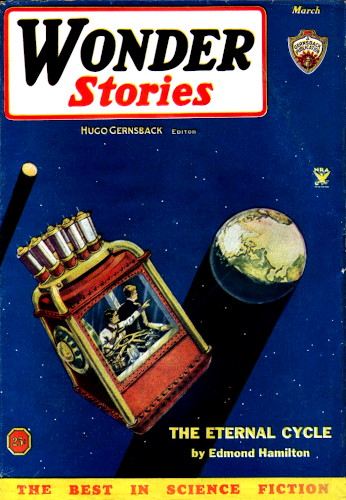
IN CAVERNS BELOW
By STANTON A. COBLENTZ
[Transcriber's Note: This etext was produced from
Wonder Stories March, April, May 1935.
It was published later using the title Hidden World.
Extensive research did not uncover any evidence that
the U.S. copyright on this publication was renewed.]
If we were told to list a dozen writers whom we considered greatscience-fiction authors, we should certainly place the name of StantonA. Coblentz high up in the list.
When Coblentz writes a short story, it is excellent, but when hecomposes a novel, such as the present one, you will have to go far andwide to find a better story.
We sincerely believe that "In Caverns Below" will go down inscience-fiction history with the other novels of Stanton A. Coblentzand will be re-read by the ever-growing multitude of science-fictionfans during future decades.
Here we find everything that distinguishes our author's work from allothers—what more can we say?
It is now five years since Philip Clay and I were given up by the worldas lost, five years since we plunged into that appalling adventurefrom which, even today, we have barely begun to recover. During ninetenths of that time, we dwelt far from the sight of our fellow men in aremote and incredible land of wizardry and terror; we made discoverieswhich, we are certain, have never been surpassed since Columbus voyagedwestward to the New World; we encountered perils that we still shudderto recall, and experienced triumphs that make us sigh regretfully inrecollection. And it is only by the rarest of good fortune that wesurvive to tell the story to those who, long ago, wept at the news ofour passing.
One fact in the case, and only one, will be remembered by the public.In the autumn of 1929, newspapers throughout the country reported thatPhilip Clay and Frank Comstock, mining engineers and boon companions,disappeared in the depths of a silver mine in Nevada. It was generallybelieved that a cave-in of unexplained origin had been responsible fortheir death, and that they had been crushed beyond recognition, for notrace of their mutilated bodies was ever found. The world, with itsinsatiable appetite for tragedy and horror, was naturally interestedfor a time, but as the days and weeks wore by and no further newswas forthcoming, public attention was diverted to other affairs, andComstock and Clay were forgotten....
Yet it is I, Frank Comstock, who write these words. It is I, FrankComstock, who a few months ago returned as if from the grave, toannounce that Clay and I had not been killed in the mine disaster. Itis I, Frank Comstock, who have come back to record my experiences, andto proclaim that, even in this twentieth century, there are more worldsabout us than our philosophy has ever taken into account.
Let me therefore go back over these harrowing five years and try toreport, as simply and accurately as I can, each episode in the wholechain of extraordinary events.
It will be needless to linger over the preliminaries, to tell how Clayand I, chums at college, had been partners since our graduation fromWestern Institute of Mining twelve years before, how we had pooledour fortunes and joined our lives and spent all of our time in mutualexperiments and enterprises in the back-regions of Montana, Idaho, andother states of the mountain belt. Passing over all this, let me tellhow, in September, 1929, we were called to pass judgment upon the oldCarlson Flat silver mine, which an eastern syndic